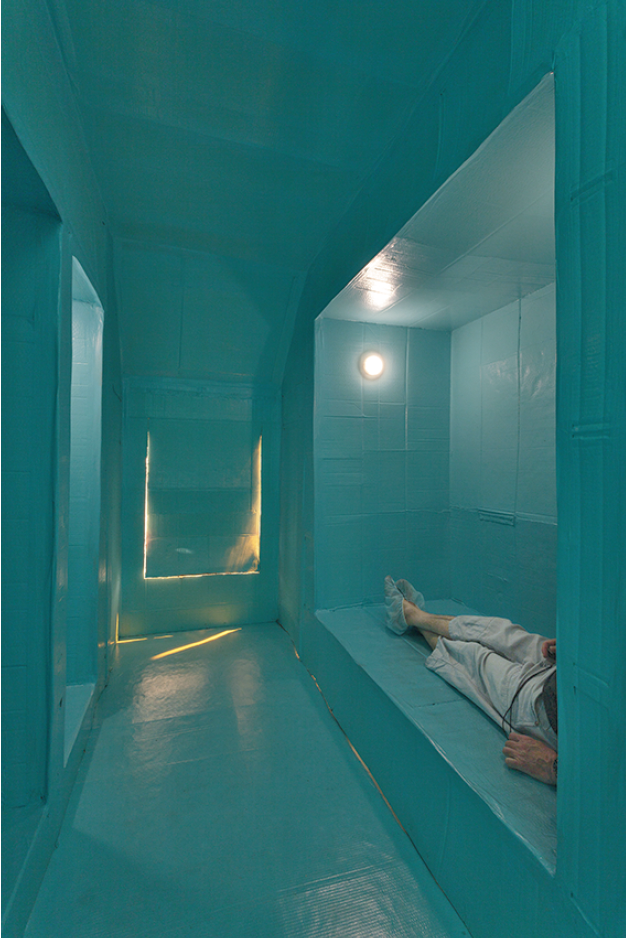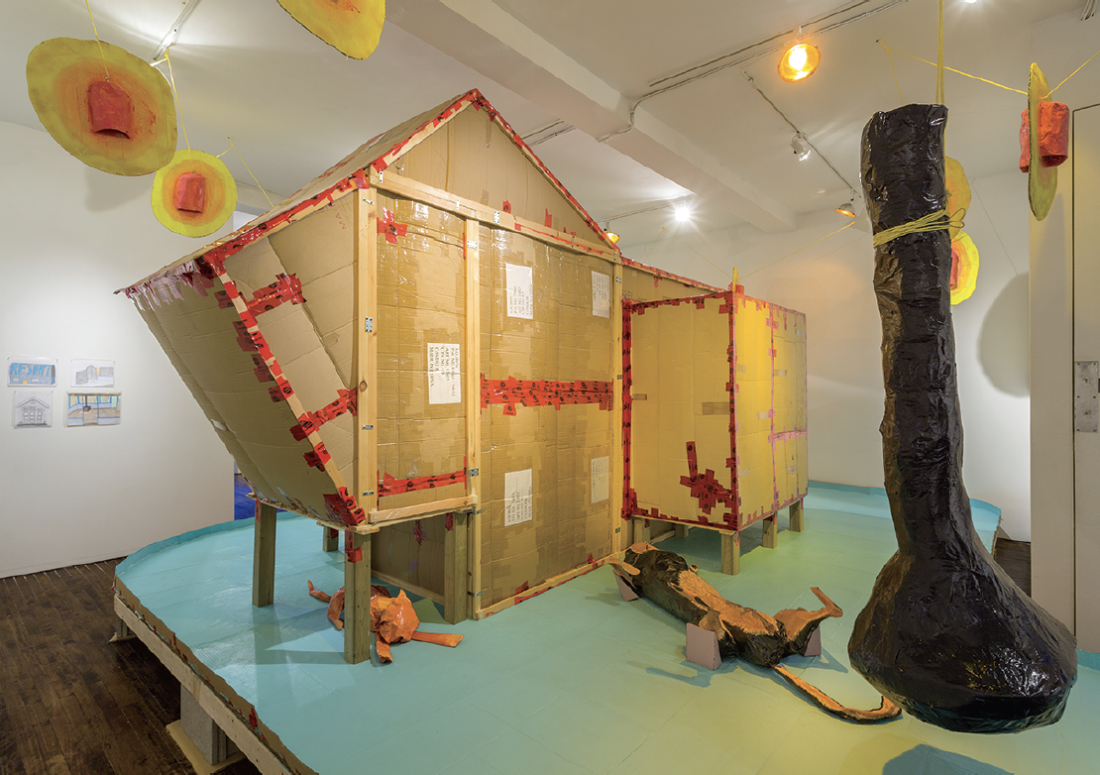Sherry Walchuk

Sherry Walchuk, installation view “For my Dad,” 2013, cardboard, paper, tape, 9’6” x 7’6” x 13’. Courtesy articule, Montreal. Photograph: Guy L’Heureux.
The main feature of Sherry Walchuk’s exhibition “For My Dad” at Articule Gallery in Montreal was a large, boxy, object-building made from recycled cardboard, reinforced with wood, and held together with strips of brightly coloured red tape. A domestic ambience prevailed in that the structure was framed by a porch-like surface, some household pets, two doghouses and appliances such as a fridge and a fireplace. Contributing to this sense—suspended in the air and marking the perimeter of the space—was a string of patio lanterns. Whereas the building itself remained unpainted, all the other items constructed out of cardboard and papier-mâché were painted. Peering into the gallery from outside, or upon first entering, the installation seemed lighthearted. This was because of the lopsided shape of certain objects, the gaudy coloration and because Walchuk’s animal-sculptures are so comically expressive: a dog lies on his back with splayed limbs, while around the corner an oversize cat seems to stand guard. But this initial impression was not the whole story by any means, because a very different interior space remained to be discovered. The visitor was in fact invited to step onto the porch area, lift a flap of cardboard and enter this piece of architecture, there encountering an interior of streamlined contours and subdued lighting painted in a cool blue. Inside, there were no furnishings or anecdotal features of any kind, although hollowed-out areas allowed a person to sit down or even lie down fully extended. If the exterior elements of this installation evoked a typical North American suburban environment, this inside space was much more mysterious. Not easy to describe, at various moments it made me think of a waiting room, an underground hideout or a spaceship.
The title of Walchuk’s exhibition is “For My Dad,” and there is a personal side to this project that speaks to the affective bonds that unite families. It refers, as well, to vernacular architecture, and to the kind of DIY practices that are a daily occurrence in the artist’s hometown of Mission, British Columbia. Walchuk has dedicated her work to family members (human and animal) in the past, usually when they are in some state of distress. For the grandfather whose bricoleur persona she inherited, she developed prosthetic-like sculptural inventions that might compensate for his decreased mobility: a wheelchair that could be transformed into a small shack, a walker that doubles as a lawn aerator. And if her grandfather’s endeavours at repairing and building things were not always successful, so too was it evident that Walchuk’s customized devices were not fully workable. Even so, their imaginative power cannot be underestimated, and perhaps we could think of them as aspirational objects. On other occasions the artist devised elaborate scenarios to increase the comfort of beloved but ailing pets.
What links these previous works to the “For My Dad” installation is a sense that the construction of new objects and spaces can correspond to the needs and desires of specific people. Whatever her father’s current predicament might be, surely that otherworldly inner-space is being offered up to him as a spatial supplement to his regular home life, perhaps as a kind of refuge. To some extent, the interior space in “For My Dad” is reminiscent of those unused nooks and in-between spaces that characterize many domestic environments—the underneath of a porch or staircase, an alcove, a deep closet, or a crawl space, for instance. The space of an empty swimming pool was also evoked largely because of the cyan-family shade of blue covering every available surface. Walchuk’s artwork seems to propose that an unrealized potential resides in such neglected spaces. What does it take then to unleash that potential, to transform a leftover fragment of domestic space into something charged, energized, empowering?

Sherry Walchuk, installation view “For my Dad,” 2013, cardboard, paper, tape, 9’6” x 7’6” x 13’. Courtesy articule, Montreal. Photograph: Guy L’Heureux
Of course Walchuk’s quasi-architectural projects, and her interest in spatiality more generally, must also be considered in relation to contemporary art practices. This frame of reference can be extended back to the 1960s and ’70s. It could be said, for instance, that Walchuk’s gesture of dissecting domestic architecture recalls Gordon Matta-Clark’s dramatic cut through an ordinary looking family home in Splitting, 1974, so that the cracked-open house could no longer serve as a container for the family unit. Walchuk’s project conveys a similar sense of pathos about architecture’s connection to familial relations and domestic life; we don’t know whether this structure is half-built or if it’s been partly dismantled. Either way the coherence of an individual dwelling has been compromised. On the other hand, the oddly protruding rooms and DIY quality of Walchuk’s spatial add-ons seem to echo the avant-garde group Ant Farm’s countercultural vision of architecture, as something that does not have to remain an elite or specialized form of knowledge. Instead, architecture can seemingly become more ephemeral and idiosyncratic as it responds to the lived experience and dreams of individuals and communities. Walchuk’s exhibition included a number of coloured-pencil drawings on small sheets of paper, and she describes her drawing practice as an opportunity to “chase shapes.” The drawings show objects and spaces that bear some resemblance to backyards, garages, shower stalls and recreational vehicles, which is to say, aspects of a middle-class domesticated environment. Rendered as two-dimensional images, though, these potentially habitable spaces become shapes, and as shapes on a page they easily shift and mutate. So for instance, the space between a garage and some stacked-up lawn furniture will become a pictorial negative space which can eventually be turned back into an object or building. The drawings thus crystallize certain moments in Walchuk’s ongoing habit of exploring (“chasing”) both spaces and shapes.

Sherry Walchuk, installation view “For my Dad,” 2013, cardboard, paper, tape, 9’6” x 7’6” x 13’. Courtesy articule, Montreal. Photograph: Guy L’Heureux
Her commitment to paper and cardboard must be mentioned, because it is the use of these materials that allows even her built structures to maintain their provisional, in-process quality, in accord with the drawings. The architectural object in “For My Dad” sits somewhere between a drawing and a real building, and is perhaps akin to what Rosalind Krauss once described as “axiomatic structures.” Walchuk makes the most of cardboard’s material attributes—its thinness and flexibility and also its tendency to fold and collapse—so that even though the exhibition’s main structures are reinforced with a solid wooden frame, it’s easy to believe that this entire scenario could be quickly dismantled and neatly folded up. The cultural status of cardboard is also significant. In Walchuk’s work (as is the case with Thomas Hirschhorn’s cardboard-centric pavilions and installations) we are reminded that cardboard boxes are privileged objects within the present day global economy because they serve as containers for virtually every new commodity that is produced and sent out into the world. The previously used cardboard boxes that were pieced together by Walchuk have product information printed on them along with pasted-on shipping labels, and the phrases “Fabriqué au Canada” and “Made in China” are evident on their surfaces. The cardboard box that was once a globally circulating artefact has stopped moving for a time, but its implied momentum is an apt counterpoint to the hidden-away island of stillness at the centre of the exhibition.
“Sherry Walchuk: For My Dad” was exhibited at Articule Gallery, Montreal, from May 3 to June 9, 2013.
Johanne Sloan teaches art history at Concordia University in Montreal.

